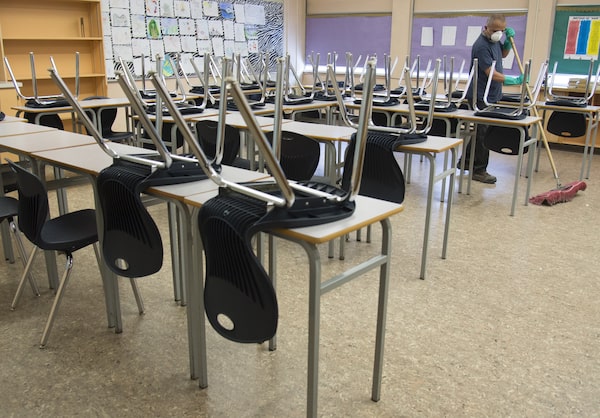
The uneasy reopening of in-class instruction this week is voluntary and part time.JONATHAN HAYWARD/The Canadian Press
Just one-third of British Columbia’s students from kindergarten to Grade 12 have returned to the classroom for the final month of the school year, despite assurances from public-health officials that pandemic safety measures in schools will keep children safe.
The union representing the province’s public-school teachers has offered reassurances to its members, too, but according to education ministry data, 10 per cent of teachers have been excused from the classroom because of COVID-19. Teachers can request an absence from the classroom if they have underlying medical vulnerabilities, unaddressed child care needs or compromised immune systems.
The uneasy reopening of in-class instruction this week, 10 weeks after classes were suspended for most students, is voluntary and part time. It will provide the framework for the next school year. School is expected to continue in September with a mix of online and in-class learning, so that physical distancing can be maintained in normally crowded classrooms and hallways.
“It’s likely that we will have to have a hybrid system again, until we have a vaccine, until the pandemic is officially over in this part of the world and around the globe,” said Education Minister Rob Fleming, speaking outside a Victoria middle school on Tuesday.
As the number of new cases of COVID-19 has declined, British Columbia has started to reopen in the past two weeks, slowly softening the string of pandemic measures imposed in March. But public-health officials warn that as restrictions are lifted, a second wave of COVID-19 cases can be expected.
Mr. Fleming said the education system will have to be prepared for another surge in the fall. “We have to prepare to be able to move forward as we have done this Monday, and move backwards when we get into the fall and winter,” he said.
The minister acknowledged that some students are struggling with the remote, online learning that has been offered this spring in lieu of in-class learning.
“Very high levels of disengagement [are] being reported by kids,” he said. “The first reason why we’re here where we are [this week] with the restart – gradual as it is – was concern about a lot of kids experiencing learning loss. Younger kids in particular are struggling with the online, remote learning.”
The hybrid model that is being offered this month, with students attending classes part time in order to reduce the risk of individuals spreading COVID-19, will provide just 20 per cent of normal in-class instruction for grades six to 12. Primary-school students are being offered half of their regular instruction hours.
Marina Milner-Bolotin, an associate professor in the University of B.C.'s Faculty of Education, said the changes imposed on education owing to the pandemic are likely going to widen the gap for students who were already struggling with school, especially students whose parents are unable to supplement their education.
“I am convinced inequality in education will grow and I’m very concerned,” Dr. Milner-Bolotin said. She urged the provincial government to provide more resources to help parents of vulnerable students to learn how to support their children’s education.
Teri Mooring, president of the BC Teachers’ Federation, said the growing gap is concerning to her members as well.
The emergency remote-learning system, and now the emerging hybrid that blends remote and in-class instruction, was created in response to the pandemic, she noted.
“It’s not something you would ever choose. It’s not ideal,” she said. “I’m concerned the gap will grow. A lot of students rely on schools for their support systems, and for those students, remote learning has been very challenging.”
The union’s leadership has been challenged by some teachers who question the return to classroom instruction. In response, the union has told its members to report any apparent violations of the health and safety protocols that have been put in place.
Student attendance has been cut back dramatically to ensure that students are spread out to maintain physical distancing, and schools are providing extra cleaning of high-touch surfaces, and additional handwashing stations.
“I do know there are teachers that are nervous about going back," Ms. Mooring said. “I’m hoping that people get more comfortable as we go through the week.”
She added that teachers have been put under a lot of stress as they adapt to new ways of teaching, as well as juggling the demands of both online and in-class instruction.
“It’s a big effort and I don’t want to sugar-coat that in any way.”
We have a weekly Western Canada newsletter written by our B.C. and Alberta bureau chiefs, providing a comprehensive package of the news you need to know about the region and its place in the issues facing Canada. Sign up today.
 Justine Hunter
Justine Hunter